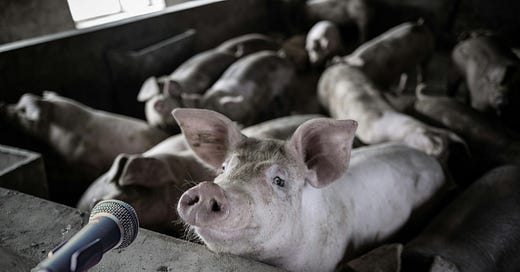Talking to Animals: How AI Could Transform Our Relationship with Other Species
And why the pursuit alone could be a defining turning point

Just a few years ago, the idea of talking to machines felt like science fiction. Today, AI systems can mimic human voices with startling realism, learn foreign languages, and even decipher complex codes — all without explicit instructions.
This rapid progress raises a fascinating question: could the same technology someday allow us to communicate with animals?
It may sound far-fetched — but it’s an idea that scientists are beginning to take seriously. If it proves even partially possible, the implications could be profound — and change our relationship with other species forever.
The race to decode the non-human world
The topic has gained so much momentum, it’s now being featured in mainstream media. Forbes recently ran a headline proclaiming: “We’re Closer To Decoding Animal Language Than You Think.” The WIRED Magazine writes: “Interspecies translation is closer than ever.”
At the heart of this movement is the Coller-Dolittle Challenge, a global competition offering $10 million in investment or $500,000 in cash to teams that can “crack the code” of animal communication.
This isn’t just about recognizing patterns in whale songs or decoding prairie dog alarm calls. The real goal is to foster genuine interspecies dialogue — to reach a point where an animal, unprompted and independently, communicates a message, without even realizing it’s communicating with a human.
As philosopher Jonathan Birch, a judge for the challenge, put it: “This prize is about understanding [animal languages] so well that we can start to join the conversation.”
Beyond the prize money, there’s a broader incentive driving this research: commercial potential. The possible applications — companion animal communication, wildlife conservation, animal behavior research — are enormous. Real interspecies understanding would open the door to entirely new industries, and whoever gets there first will claim not only fame, but fortune.
A technological turning point for animal advocacy?
Whether or not full-scale “animal translators” arrive soon, the questions this research raises are already transformative.
If we begin to truly understand the feelings, desires, and social lives of animals—not just in theory, but through their own “voices” — it could profoundly shift how society sees and treats them. Aza Raskin, co-founder of the Earth Species Project, likens this moment to the invention of telescopes and microscopes — tools that shattered illusions and expanded human understanding.
“I think we’re about to experience and understand the cultures of Earth that humans have never really been able to see or hear or understand. And we are on the very cusp of that happening.”
— Aza Raskin
If he’s right, this could mark a historic turning point: the moment we stopped projecting onto animals — and started listening.
AI may break through desensitization in ways traditional advocacy cannot. Imagine a viral clip where we not only hear animals cry out — but actually understand what they’re saying:
A dairy calf, just separated from his mother, calling out for her in panic.
A cow resisting the kill chamber, sensing what lies ahead.
A mother pig, locked in a crate, trying to comfort her helpless young.
Even hardened skeptics might pause, if only for a moment, and reconsider their choices. If machine learning and large language models can accelerate a moral awakening, we should welcome them — not as a substitute for action, but as a catalyst.
“The ability to speak doesn’t always protect — not even for humans”
Some may ask: if most humans can speak, and yet violence, exploitation, and injustice persist in our society, what makes us think that AI translators will protect animals? Clearly, the ability to speak doesn’t automatically ensure safety — not even for humans.
However, it’s important to recognize that speech often does make a meaningful difference. The power to describe one’s own suffering — to testify, to plead, to demand justice—has historically stirred empathy, sparked outrage, and mobilized support. It’s not always enough, but it frequently moves hearts and shifts public opinion.
Crimes against humanity are often met with widespread condemnation. By contrast, the intense and systematic exploitation of farmed animals is still normalized, legal, and accepted by billions. Beings who can’t communicate with us directly are, sadly, more easily reduced to mere objects.
We might be on the verge of something extraordinary
Precisely because animals have never spoken to us in our own language, hearing them do so — even artificially — could deliver a cultural shock powerful enough to break through apathy, dominate headlines, and force society to reckon with their suffering in a radically new way.
Whether we cross the line into true interspecies communication or not, the journey itself could profoundly change how we relate to the rest of life on Earth.
Hopefully, this — along with other hopeful developments already underway — will help us learn to listen, before it’s too late.
Vegan Horizon is made possible by readers like you. If you'd like to support this project and help it grow, please consider joining as a free or paid subscriber.




AI has helped to identify names of elephants, and use those names to call that animal (played over a speaker)
https://www.nature.com/articles/s41559-024-02420-w
Awesome! I wish I wrote this, haha! I use AI a lot in my daily life, and yet I am still most excited for this. Not just to hear what we know animals are already saying: "stop," but to see how we could communicate to collaborate. Would they ask for sanctuary?